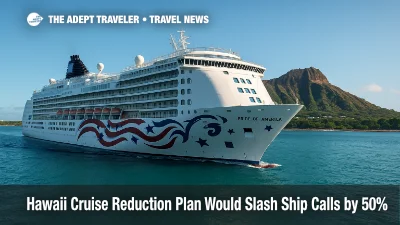Hawaii cruise reduction plan would slash ship calls 50 %

Hawaii's draft Energy Security and Waste Reduction Plan proposes cutting non-home-ported cruise calls in half by 2030 and by 75 percent five years later, framing the move as a fast-track to climate goals.
Key Points
- Why it matters: Cruise visitors spend about $65 million a year in the islands.
- Travel impact: A 50 percent cut in cruise calls could trim 250 000 annual visitors.
- What's next: Public comments on the plan close Aug. 31; lawmakers will review targets in 2026.
- Norwegian Cruise Line's Pride of America is exempt as Hawaii's sole home-port vessel.
- Ports may soften limits if visiting ships adopt shore power and cleaner, dual-fuel engines.
Snapshot
Under the draft emissions plan, Hawaii's Department of Transportation (HDOT) sets a two-step cap on visiting cruise traffic: a 50 percent cut from 2023 levels by 2030, followed by a 75 percent reduction by 2035. The marine benchmarks sit inside a broader emissions plan that pursues net-negative transport by 2045. Officials say the islands have not yet seen vessels equipped to plug into shore power or burn methanol, renewable LNG, or bio-diesel at scale, making call caps the quickest path to near-term greenhouse-gas reduction. The measures exclude ships home-porting in Hawaii-currently only NCL's Pride of America-to preserve inter-island cruise capacity while still slashing visiting tonnage.
Background
Tourism is Hawaii's economic engine, but it comes with a heavy carbon footprint, especially in shipping and aviation. HDOT's 205-page Energy Security and Waste Reduction Plan outlines mode-specific targets across air, ground, and marine transport. For cruise, the plan cites 2023 as the baseline and notes that visiting ships accounted for a sizeable share of harbor emissions. Shore-side electrification is years away for most ports, and alternative marine fuels remain costly or unavailable in the Pacific. As a result, officials selected arrival caps as a "no-regrets" step while cleaner technology matures. The proposal mirrors European ports such as Venice and Nice, where capacity limits preceded fuel-switch mandates.
Latest Developments
Business leaders warn of economic fallout
The Grassroot Institute of Hawaii estimates the call cuts could erase $65 million in annual visitor spending and jeopardize jobs in shore excursions, dining, and retail. Industry groups argue that cruise travelers disperse spending to Neighbor Islands that see fewer air arrivals, cushioning local economies still recovering from the 2023 Maui fires.
Ports hint at flexibility for greener ships
HDOT Deputy Director Dre Kalili told stakeholders the state may revisit the benchmarks if lines deploy dual-fuel vessels and commit to shore-power connections once infrastructure is installed. The agency is also studying per-visit emissions fees and incentives for smaller expedition vessels-an option cruise executives say could preserve itinerary variety while meeting the emissions plan.
Public comment window extended
Responding to high interest, HDOT pushed the feedback deadline to Aug. 31 and scheduled virtual town-halls in mid-August. Final recommendations will be sent to the 2026 legislature, which could codify the cruise-call cap or adjust targets based on technological progress.
Analysis
Hawaii's cruise-call cap is the most aggressive maritime emissions plan proposed by any U.S. state. For global brands, the immediate challenge is itinerary disruption: lines will need to re-route Pacific repositioning voyages or add extra sea days to comply. Norwegian Cruise Line enjoys a home-port exemption, giving Pride of America a competitive edge in the inter-island market. Yet even NCL faces reputational risk if overall cruise capacity shrinks and policymakers link the brand to climate concerns.
From a sustainability lens, Hawaii's strategy trades visitor numbers for speed-slashing cruise calls produces measurable gains without waiting for fleet-wide fuel transitions. Critics counter that the approach penalizes a single sector while leaving aviation-the state's largest transport emitter-largely untouched until sustainable aviation fuel becomes viable. Economically, cruise passengers represent only about eight percent of Hawaii's annual visitors, but they spend in concentrated port communities. A sharp reduction may ripple through tour operators already navigating tighter margins post-pandemic.
The pivotal variable is technology adoption. If methanol-ready ships like MSC's World Europa or shore-power-equipped vessels begin frequenting Honolulu, HDOT could allow more calls under an emissions-per-port-visit formula. In effect, Hawaii is using scarcity to spur innovation-rewarding lines that deploy the cleanest ships first. The next 18 months will reveal whether cruise companies pivot technology investment toward Pacific routes or focus on more accessible markets with existing green-port infrastructure in Europe and North America.
Final Thoughts
Hawaii's proposed Hawaii cruise reduction targets set a new bar for maritime climate policy in the United States. Travelers planning an island sailing after 2030 should expect fewer itinerary choices unless cruise lines accelerate alternative-fuel adoption. Watch how the public comment period, legislative debate, and tech upgrades evolve-each could reshape the final contours of the Hawaii cruise reduction plan.
